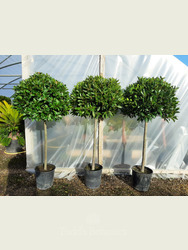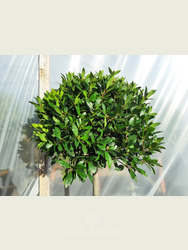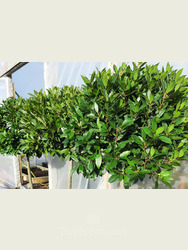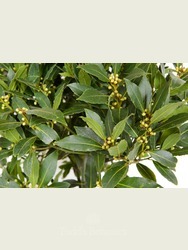Large Head Standard Bay Tree
Overall Height: 175cm (inc. container)
Stem Height: 80-90cm
Diameter of Head: 65-75cm cm
Container Size: 30cm
Large Head Standard Laurus nobilis
Delivered by economy pallet service usually taking 2-3 days
Bay trees are a popular evergreen decorative shrub and this stunning large headed version is equally suited to planting in a statement container or directly in to the ground. Their flexibility and versatility make bay trees ideal for a variety of locations. Used in pairs, bay trees are the perfect way to grace an entrance, doorway or steps, or in multiples they look stunning placed along paths or lining walkways for all year round evergreen interest.
Evergreen Bay Trees let you enjoy rich, dark green leaves all seasons with only minimal maintenance. In addition, they make the perfect tree for topiarists of all abilities, being easily shaped to create attractive displays. Bay trees aren't, however, just an attractive way to keep your garden looking green throughout the winter months; bay leaves are a popular ingredient in many dishes worldwide and will add a fragrant and aromatic flavour to your soups, stews and curries.
This large bay tree is an impressive size standing at 175cm including the pot and the head measures around 65-75cm in diameter. You can buy bay trees of all sizes, singularly or in pairs from our RHS award winning nursery. We offer nationwide delivery on our wide selection of small and large trees. For more information on how to care for bay trees please read our bay tree care notes.
Where more than one tree is ordered we will do our best to match up trees to pair well together. We recommend http://www.vasotoscano.com/ for fabulous frostproof terracotta pots. We send out a care note with every order detailing all the feeding, watering and planting requirements.
Please note that these trees will be delivered on a 2-3 day economy pallet kerbside delivery service. Please feel free to get in touch to discuss delivery requirements prior to ordering.
-
Situation Open Close
Box and bay topiary is suitable in full sun, part shade or full shade, watering just needs to be adjusted accordingly. A sheltered site best suits bay in winter, as it is less resilient than box in a very hard winter. Box and bay both suit all soil types apart from waterlogged! In a container, a soil based compost such as John Innes No.3 with added organic matter and coarse grit to aid stability and drainage would be ideal.
Box balls, pyramids and spirals for sale, best in the UK and fast delivery, Click here.
To buy Bay trees, standards, lollipops and cones Click here.
-
Feeding Open Close
Containerised topiary plants rely on you for all their feed and watering requirements. Feed with a general purpose fertilizer such as Vitax Q4 once a month from Apr-Jul. Discolouration of foliage is usually due to lack of feeding - white or orange tips on box indicates potassium deficiency, as does an overall bronzing of the foliage. In both instances feed with Vitax Q4 regularly spring-summer. In bay, yellow leaves would likely indicate a lack of feed too.
-
Pruning Open Close
As a minimum, prune topiary during early June then again in October to shape it up ready for winter. Alternatively, trim little and often throughout the growing season. It is important not to trim box in hot weather otherwise the cut edges can scorch. It is best to trim bay with secateurs to avoid unsightly cut leaves that will turn brown. Topiary shears or a small hedge-trimmer are ideal for trimming box to shape.
-
Watering Open Close
Don't rely on rainfall to water containerised topiary; the foliage is so dense that little, if any, rain would reach the soil. Water container grown plants throughout the growing season (Apr-Sept). The frequency depends on the sun/shade situation of the plants and the weather conditions. The symptoms of drought for box are the new growth turning blue and wilting, and the older growth turning yellow/orange. On bay, wilting of new growth is easier to spot. Waterlogging can also be a problem if the container does not drain between watering or sits in water.
-
Pests and Diseases Open Close
On bay, low numbers of yellow leaves is part of the natural shedding process; these can just be picked off if too unsightly. However, if an excessive amount of yellow leaves appear this can be a symptom of waterlogging; check the compost. Black leaf spots on bay also signifies waterlogging, or old, tired compost, re-pot removing the bottom third of compost by gently teasing out the root ball and also the top 5cm of the compost. The roots can also be lightly pruned to aid re-potting.
-
Winter Care Open Close
Containerised topiary can be susceptible to a frozen rootball in a very hard winter if the pot is relatively small, ideally move to a sheltered position. Be careful not to trim topiary too early in the season as new growth is very susceptible to frost damage. Late May/early June is ideal for the first trim of the year. Bay are more susceptible than box to winter foliage damage, a sheltered position will help to minimise this.






